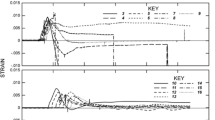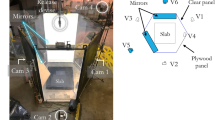Abstract
The dynamic fragmentation of coarse and fine grained granitoid blocks during impact has been examined for energies of 1.9 kJ to 3.0 kJ and 2.7 kJ to 6.8 kJ, respectively. A particle tracking algorithm was developed to measure ejecta size and velocity at the rear of the target for a horizontal railgun arrangement. Fragments for the finer-grained material are smaller than the coarser-grained specimens as a result of enhanced comminution of fractured surfaces and increased intergranular fracture. Length scales > 6 mm contain > 80 % of the total mass and kinetic energy. Median ejection velocities increase for increasing impact energy (range from 5 m/s to 10 m/s for both materials). These are low in comparison to incoming projectile velocity (250 m/s to 500 m/s) and indicate that the bulk of incoming energy is dissipated into forms other than kinetic energy transfer (e.g., heat and comminution). Approximately 25 % of the mass and 80 % of the kinetic energy is contained in velocities > 20 m/s. The total conversion of impact energy to ejecta kinetic energy is estimated as approximately 3 % for the coarser material and 4 % for the finer grained material. The % conversion to momentum is higher, increasing from 7 % to 11 % for the coarser grained material and 21 % to 30 % for the finer grained material. This highlights the importance of momentum transfer during impact testing at low speeds into blocks.
















Similar content being viewed by others
References
Mott N (1943) A theory of the fragmentation of shells and bombs. Technial Report AC4035, United Kingdom Ministry of Supply
Grady DE (1988) The spall strength of condensed matter. J Mech Phys Solids 36:353–384
Shockey DA, Curran DR, Seaman L, Rosenberg JT, Petersen CF (1974) Fragmentation of rock under dynamic loads. Int J Rock Mech Min. Sci 11(8):303–317
Grady DE (2009) Length scales and size distributions in dynamic fragmentation. Int J Fract 163(1–2):85–99
Meyers MA, Aimone CT (1983) Dynamic fracture (spalling) of metals. Prog Mater Sci 28(1):1–96
French BM (1998) Traces of catastrophe: a handbook of shock-metamorphic effects in terrestrial meteorite impact structures. LPI contribution No. 954. Lunar and Planetary Institute, Houston
Aler J, Mouza JD, Arnould M (1996) Measurement of the fragmentation efficiency of rock mass blasting and its mining applications. Int J Rock Mech Min Sci Geomech Abstr 33(2):125–139
Strassburger E (2009) Ballistic testing of transparent armour ceramics. J Eur Ceram Soc 29(2):267–273. Special Issue on Transparent Ceramics
Cox BN, Gao H, Gross D, Rittel D (2005) Modern topics and challenges in dynamic fracture. J Mech Phys Solids 53(3):565–596
Zhou F, Molinari JF, Ramesh K (2006) Analysis of the brittle fragmentation of an expanding ring. Comput Mater Sci 37(1–2):74–85
Zhou F, Molinari JF, Ramesh KT (2006) Effects of material properties on the fragmentation of brittle materials. Int J Fract 139:169–196
Rong C, Xiao-Xin Y, Hung-Sen X (1979) Studies of the fracture of gabbro. Int J Rock Mech Min Sci 16(3):187–193
Kocer C, Collins RE (1998) Angle of hertzian cone cracks. J Am Ceram Soc 81(7):1736–1742
Shipway PH, Hutchings IM (1993) Fracture of brittle spheres under compression and impact loading. I. Elastic stress distributions. Philos Mag A 67(6):1389–1404
Shenoy V, Kim K-S (2003) Disorder effects in dynamic fragmentation of brittle materials. J Mech Phys Solids 51(11–12):2023–2035
Kolmogorov A (1991) The local structure of turbulence in incompressible viscous fluid for very large reynolds numbers. Proc R Soc Lond A 434:9–13
Shockey DA, Marchand A, Skaggs S, Cort G, Burkett M, Parker R (1990) Failure phenomenology of confined ceramic targets and impacting rods. Int J Impact Eng 9(3):263–275
Chin ESC (1999) Army focused research team on functionally graded armor composites. Mater Sci Eng A 259(2):155–161
Goncalves DP, de Melo FCL, Klein AN, Al-Qureshi HA (2004) Analysis and investigation of ballistic impact on ceramic/metal composite armour. Int J Mach Tools Manufact 44(2–3):307–316
Wilkins ML (1978) Mechanics of penetration and perforation. Int J Eng Sci 16(11):793–807. Special Issue: Penetration Mechanics
Spray JG (2010) Frictional melting processes in planetary materials: from hypervelocity impact to earthquakes. Annu Rev Earth Planet Sci 38(1):221–254
Marder M, Gross S (1995) Origin of crack tip instabilities. J Mech Phys Solids 43(1):1–48
Holland L (1984) Distributed-current-feed and distributed-energy-store railguns. IEEE Trans Magn 20(2):272–275
Poltanov A, Kondratenko A, Glinov A, Ryndin V (2001) Multi-turn railguns: concept analysis and experimental results. IEEE Trans Magn 37(1):457–461
Pappas J, Piccone D (2001) Power converters for railguns. IEEE Trans Magn 37(1):379–384
Schneider M, Liebfried O, Stankevic V, Balevicius S, Zurauskiene N (2009) Magnetic diffusion in railguns: measurements using cmr-based sensors. IEEE Trans Magn 45(1):430–435
Holsapple KA, Schmidt RM (1980) On the scaling of crater dimensions 1: explosive processes. J Geophys 85:7247–7256
Holsapple KA, Schmidt RM (1982) On the scaling of crater dimensions 2: impact processes. J Geophys 87:1849–1870
Walker J, Chocron S (2008) Near-earth object deflection using conventional explosives. Int J Impact Eng 35(12):1473–1477
Saito T, Kaiho K, Abe A, Katayama M, Takayama K (2008) Hypervelocity impact of asteroid/comet on the oceanic crust of the earth. Int J Impact Eng 35(12):1770–1777
Hogan JD, Spray JG, Rogers RJ, Boonsue S, Vincent G, Schneider M (2011) Micro-scale energy dissipation mechanisms during dynamic fracture in natural polyphase ceramic blocks. Int J Impact Eng 38(12):931–939
Grady DE, Kipp ME (1979) The micromechanics of impact fracture of rock. Int J Rock Mech 16(5):293–302
Giblin I (1998) New data on the velocity-mass relation in catastrophic disruption. Planet Space Sci 46(8):921–928
Hartmann WK (1985) Impact experiments: 1. Ejecta velocity distributions and related results from regolith targets. Icarus 63(1):69–98
Melosh H (1987) High-velocity solid ejecta fragments from hypervelocity impacts. Int J Impact Eng 5(1–4):483–492. Hypervelocity Impact Proceedings of the 1986 Symposium
Polanskey CA, Ahrens TJ (1990) Impact spallation experiments: fracture patterns and spall velocities. Icarus 87(1):140–155
Nakamura A, Fujiwara A (1991) Velocity distribution of fragments formed in a simulated collisional disruption. Icarus 92(1):132–146
Kamminga H (1982) Life from spacea history of panspermia. Vistas Astron 26:67–86
Gault D, Heitowit E (1963) The partition of energy for hypervelocity impact craters formed in rock. Proc. 6th Hypervelocity Impact Symp 2(2)419–456
Fujiwara A, Tsukamoto A (1980) Experimental study on the velocity of fragments in collisional breakup. Icarus 44(1):142–153
Braslau D (1970) Partitioning of energy in hypervelocity impact against loose sand targets. J Geophys Res 75(20):3987–3999
Hermalyn B, Schultz PH (2010) Early-stage ejecta velocity distribution for vertical hypervelocity impacts into sand. Icarus 209(2):866–870
Michikami T, Moriguchi K, Hasegawa S, Fujiwara A (2007) Ejecta velocity distribution for impact cratering experiments on porous and low strength targets. Planet Space Sci 55(12):70–88
Hogan JD, Spray JG, Rogers RJ, Vincent G, Schneider M (2013) Dynamic fragmentation of natural ceramic tiles: ejecta measurements and kinetic consequences. Int J Impact Eng 58:1–16
Matlab User Manual (2013)
Kick F (1885) Das gesetz des proportionalen widerstandes und seine anwendung. Arthur Felix, Leipzig
Housen KR, Holsapple KA (2011) Ejecta from impact craters. Icarus 211(1):856–875
Jutzi M, Michel P, Benz W, Richardson DC (2010) Fragment properties at the catastrophic disruption threshold: the effect of the parent bodys internal structure. Icarus 207(1):54–65
Artemieva NA, Wünnemann K, Krien F, Reimold WU, Stöffler D (2013) Ries crater and suevite revisited—Observations and modeling Part II: Modeling. Meteorit Planet Sci 48(4):590–627. doi:10.1111/maps.12085
Hukki RT (1961) Proposal for a solomonic settlement between the theories of von Rittinger, Kick and Bond. SME-AIME 220:403–408
Schultz PH (1992) Atmospheric effects on ejecta emplacement. J Geophys Res Planet 97(E7):11623–11662
Acknowledgments
This work was supported by a Natural Sciences and Engineering Research Council (NSERC) PGS-D scholarship to JDH and funding from NSERC, the Canada Research Chairs program and the Canada Foundation for Innovation to JGS. The authors would also like to thank the effort and contribution during the experimental phase of the study of Yannick Boehrer, David Bluntzer and Philippe Baumann at ISL. Suporn Boonsue kindly assisted with the electron microscopy. Planetary and Space Science Centre contribution 75.
Author information
Authors and Affiliations
Corresponding author
Rights and permissions
About this article
Cite this article
Hogan, J.D., Rogers, R.J., Spray, J.G. et al. Debris Field Kinetics during the Dynamic Fragmentation of Polyphase Natural Ceramic Blocks. Exp Mech 54, 211–228 (2014). https://doi.org/10.1007/s11340-013-9777-7
Received:
Accepted:
Published:
Issue Date:
DOI: https://doi.org/10.1007/s11340-013-9777-7




